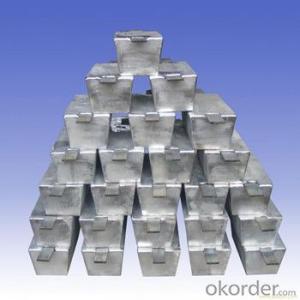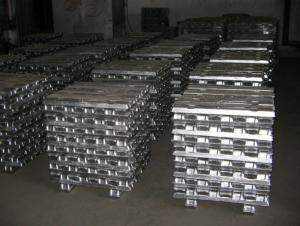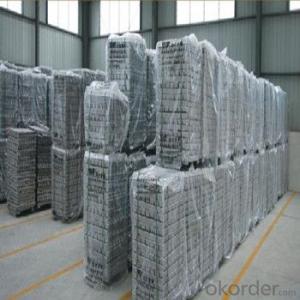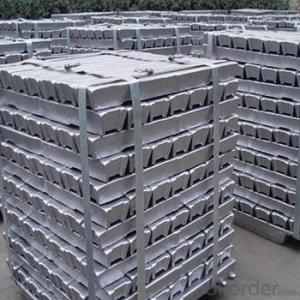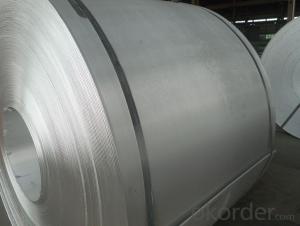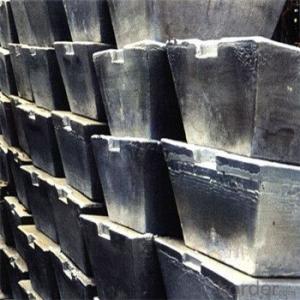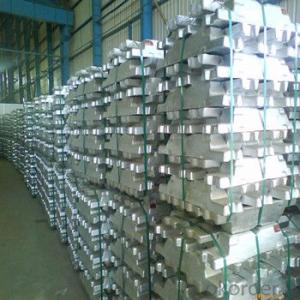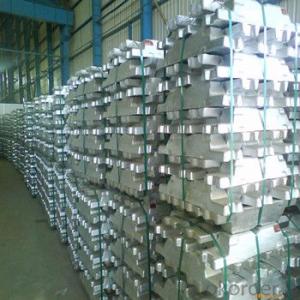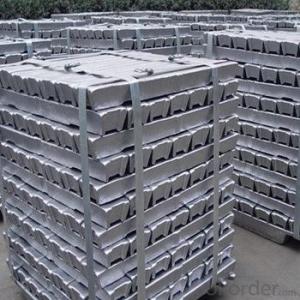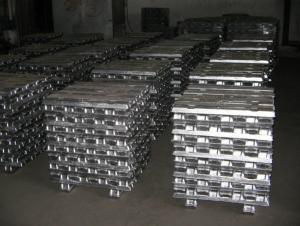Aluminum Ingot Primary/ Pure Aluminium Ingot/Aluminium Ingot 99.7%
- Loading Port:
- China main port
- Payment Terms:
- TT OR LC
- Min Order Qty:
- 1000 m.t.
- Supply Capability:
- 10000 m.t./month
OKorder Service Pledge
OKorder Financial Service
You Might Also Like
Pure Aluminum Ingot Used for Industry
1.Structure of Aluminum Ingot Description
An ingot is a piece of material, usually metal, that is cast into a shape suitable for further processing. Insteelmaking, it is the first step among semi-finished casting products. Ingots usually require a second procedure of shaping, such as cold/hot working, cutting, or milling to produce a useful final product. Non-metallic and semiconductor materials prepared in bulk form may also be referred to as ingots, particularly when cast by mold based methods.
2.Main Features of the Aluminum Ingot
•High Purity
•High strength
•Fast melting
•Best price
•Good after-service
3. Aluminum Ingot Images
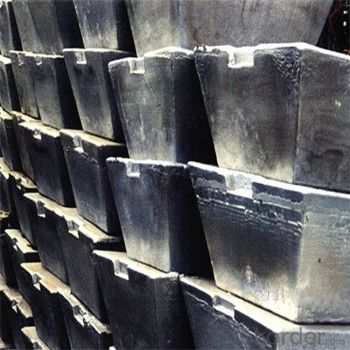
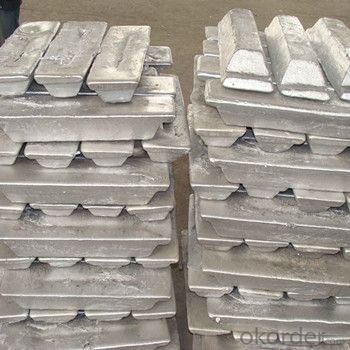
4. Aluminum Ingot Specification
Grade | Chemical Composition % | |||||||||
Al≥ | impurities ≤ | |||||||||
Si | Fe | Cu | Ga | Mg | Zn | Mn | others | Sum | ||
Al99.9 | 99.90 | 0.50 | 0.07 | 0.005 | 0.02 | 0.01 | 0.025 | - | 0.010 | 0.10 |
Al99.85 | 99.85 | 0.80 | 0.12 | 0.005 | 0.03 | 0.02 | 0.030 | - | 0.015 | 0.15 |
Al99.7 | 99.70 | 0.10 | 0.20 | 0.010 | 0.03 | 0.02 | 0.030 | - | 0.030 | 0.30 |
Al99.6 | 99.60 | 0.16 | 0.25 | 0.010 | 0.03 | 0.03 | 0.030 | - | 0.030 | 0.40 |
Al99.5 | 99.50 | 0.22 | 0.30 | 0.020 | 0.03 | 0.05 | 0.050 | - | 0.030 | 0.50 |
Al99.00 | 99.00 | 0.42 | 0.50 | 0.020 | 0.03 | 0.05 | 0.050 | - | 0.050 | 1.00 |
5.FAQ of Aluminum Ingot
We have organized several common questions for our clients,may help you sincerely:
①How about your company?
A world class manufacturer & supplier of castings forging in carbon steel and alloy steel,is one of the large-scale professional investment casting production bases in China,consisting of both casting foundry forging and machining factory. Annually more than 8000 tons Precision casting and forging parts are exported to markets in Europe,America and Japan. OEM casting and forging service available according to customer’s requirements.
②How to guarantee the quality of the products?
We have established the international advanced quality management system,every link from raw material to final product we have strict quality test;We resolutely put an end to unqualified products flowing into the market. At the same time, we will provide necessary follow-up service assurance.
③How long can we receive the product after purchase?
In the purchase of product within three working days, We will arrange the factory delivery as soon as possible. The pecific time of receiving is related to the state and position of customers.Commonly 7 to 10 working days can be served.
- Q:How are aluminum ingots used in the production of appliances?
- Aluminum ingots play a significant role in the production of appliances due to their inherent properties and characteristics. They are primarily used in the manufacturing process to create the outer casings, frames, and components of various appliances. One of the key reasons for using aluminum ingots is their lightweight nature. Aluminum is known to be a lightweight metal, making it an ideal choice for appliances where weight reduction is a crucial factor. This property allows manufacturers to design and produce appliances that are easier to handle, transport, and install. Additionally, aluminum ingots offer excellent corrosion resistance, which is essential for appliances that may come into contact with water or other corrosive substances. This property ensures that the appliances remain durable and long-lasting, maintaining their functionality and appearance over time. Another advantage of using aluminum ingots is their high thermal conductivity. This property enables appliances to distribute and dissipate heat efficiently, making them more energy-efficient and reducing the risk of overheating. This is particularly crucial for appliances such as refrigerators, air conditioners, and cooktops. Moreover, aluminum ingots are highly malleable and can be easily molded or formed into various shapes and sizes. This characteristic allows manufacturers to create intricate designs and customize the appearance of appliances according to consumer preferences. It also facilitates the integration of different components, such as handles, hinges, and buttons, into the appliance structure. Furthermore, aluminum ingots are recyclable, making them an environmentally friendly choice. The recycling process requires significantly less energy compared to the production of primary aluminum, reducing the carbon footprint associated with appliance manufacturing. In summary, aluminum ingots are extensively used in the production of appliances due to their lightweight nature, corrosion resistance, high thermal conductivity, malleability, and recyclability. These properties contribute to the production of appliances that are durable, energy-efficient, aesthetically pleasing, and environmentally friendly.
- Q:How are aluminum ingots alloyed with other metals?
- Aluminum ingots can be alloyed with other metals through various methods. One common method is through the process of melting. Aluminum ingots and the desired alloying metal are melted together at high temperatures, allowing the atoms of the two metals to mix and form a homogeneous mixture. This method is commonly used for alloys with low melting points or when a uniform distribution of the alloying metal is required. Another method is through the process of casting. In this method, molten aluminum is poured into a mold that contains a specific amount of the alloying metal. As the aluminum cools and solidifies, it incorporates the alloying metal into its structure, creating an alloy. This method is often used for alloys that require precise compositions and when a specific shape or form is desired. Furthermore, aluminum ingots can also be alloyed through powder metallurgy. In this process, powdered forms of aluminum and the alloying metal are mixed together thoroughly. The mixture is then compacted under high pressure and heated to a temperature below the melting point of the aluminum. This allows the atoms of the alloying metal to diffuse into the aluminum particles, resulting in a solid-state alloy. Additionally, there are also methods such as electroplating and vapor deposition that can be utilized to alloy aluminum ingots with other metals. These methods involve the deposition of a thin layer of the alloying metal onto the surface of the aluminum ingots through electrochemical or physical processes. Overall, the alloying of aluminum ingots with other metals can be achieved through various techniques, each with its own advantages and applications. The choice of method depends on factors such as the desired composition, the physical properties required, and the specific manufacturing process involved.
- Q:How are aluminum ingots protected from corrosion?
- Aluminum ingots are protected from corrosion through various methods such as applying a protective coating, using proper storage conditions, and employing corrosion inhibitors.
- Q:How are aluminum ingots used in the packaging industry?
- Due to their unique properties and versatility, aluminum ingots play a crucial role in the packaging industry. Various types of aluminum packaging materials, such as cans, foils, containers, and lids, are primarily manufactured using these ingots. Aluminum cans are one of the primary uses of aluminum ingots in the packaging industry. They are widely preferred for packaging beverages like soft drinks, beer, and energy drinks. The lightweight nature of aluminum cans makes them easy to transport and stack, making them more preferable than other materials. Moreover, aluminum cans provide excellent protection against light, oxygen, and moisture, ensuring the freshness and quality of the packaged product. Aluminum foils are another common application of aluminum ingots in the packaging industry. They are used for wrapping food items like chocolates, snacks, and pre-cooked meals. Aluminum foils are also used for sealing bottles and containers. The remarkable barrier properties of aluminum foils prevent the entry of air, moisture, and contaminants, preserving the taste, texture, and overall quality of the packaged food. Aluminum ingots are also utilized in manufacturing aluminum containers, which are commonly known as trays or pans. These containers are extensively used for packaging ready-to-eat meals and takeout food. With their lightweight, durable, and high-temperature resistance properties, aluminum containers are suitable for both cooking and reheating. Furthermore, aluminum ingots are employed in the production of aluminum lids and closures used in the packaging industry. These lids are designed to fit tightly on various packaging materials, ensuring the safety and integrity of the packaged products. Aluminum lids provide an effective seal, preventing leakage, contamination, and tampering. In conclusion, the packaging industry widely utilizes aluminum ingots due to their excellent properties like corrosion resistance, lightweight, and malleability. By using aluminum ingots, the packaging industry can produce sustainable, durable, and high-quality packaging materials that meet the demands of modern consumers.
- Q:What is the average weight of an aluminum ingot?
- The average weight of an aluminum ingot varies depending on its size and shape. However, a common average weight for an aluminum ingot is around 25 to 30 pounds (11 to 14 kilograms).
- Q:What is the aluminum ingot smelting
- Aluminum is a commonly known as recovery. Aluminum is a chemical element. Its chemical symbol is Al, and its atomic number is 13. Aluminum is the third largest in the earth's crust, second only to oxygen and silicon, and is the most abundant metal element in the earth's crust. Among the metal varieties, second only to steel, they are the second major metals. Until the end of nineteenth Century, it has become the competitive aluminum made in the engineering application of the metal, and come into fashion. Aluminum is widely used in construction, automotive, aviation, the development of three major industries, the unique properties of material properties of aluminum and its alloys, which greatly facilitates the production and application of recycled aluminum metal.
- Q:How much does it cost to process the aluminum ingots into T5-6063 models? Now, what about costing the aluminum ingot or the aluminum bar?
- T6 is artificially aged by solid solution heat treatmentIt is suitable for the products which are treated by solid solution heat treatment, no longer cold processing (can be straightened and leveling, but does not affect the mechanical performance limit)
- Q:What are the different machining techniques for aluminum ingots?
- Aluminum ingots can be machined using various techniques to achieve different results. Some commonly used techniques include: 1. Turning: To create desired shapes or sizes, a cutting tool is employed to remove material from the surface of the aluminum ingot. This technique is commonly applied to produce cylindrical parts like rods or shafts. 2. Milling: By using a rotating cutting tool, material is removed from the surface of the aluminum ingot to create different shapes and features such as slots, pockets, and complex contours. 3. Drilling: This technique involves the creation of holes in the aluminum ingot using a rotating cutting tool. Holes of various sizes and depths can be achieved through this method. 4. Grinding: An abrasive wheel is utilized in this machining process to eliminate material from the surface of the aluminum ingot. Grinding is commonly employed to attain a smooth and precise surface finish. 5. Boring: To enlarge an existing hole in the aluminum ingot, a single-point cutting tool is used in this machining process. Boring is often used to create holes with larger diameters. 6. Sawing: The aluminum ingot is cut into desired lengths or shapes using a saw blade in this machining technique. Sawing is frequently utilized to divide aluminum ingots into smaller pieces for further processing. 7. Lathing: In this machining technique, the aluminum ingot is rotated while a cutting tool is employed to remove material from its surface. Lathing is commonly used to create symmetrical parts like cones or spheres. These are merely a few examples of the numerous machining techniques available for working with aluminum ingots. The choice of technique depends on the desired shape, size, and surface finish of the final product.
- Q:What are the different surface finishes available for aluminum ingots?
- The different surface finishes available for aluminum ingots include mill finish, brushed finish, anodized finish, powder-coated finish, and polished finish.
- Q:What are the different methods for machining aluminum ingots?
- Depending on the desired shape, size, and accuracy needed for the final product, there are various methods available for machining aluminum ingots. Some commonly used methods include the following: 1. Milling: Utilizing a rotating cutter, material is removed from the ingot to create the desired shape. This method is suitable for producing flat surfaces, slots, and holes. 2. Turning: By rotating the ingot while a cutting tool removes material, cylindrical shapes can be achieved. Turning is often used for creating shafts, rods, and other cylindrical components. 3. Drilling: Holes of different sizes and depths can be created in the aluminum ingot by employing a rotating tool with cutting edges. 4. Grinding: This method involves using abrasive wheels or belts to remove material from the ingot's surface, resulting in a smooth and precise finish. It is commonly used to attain tight tolerances and precise dimensions. 5. Sawing: By cutting through the aluminum ingot with a saw blade, desired shapes can be produced or the ingot can be separated into smaller pieces, such as bars or billets. 6. Waterjet cutting: This process utilizes a high-pressure stream of water mixed with abrasive particles to cut through the aluminum ingot. It is capable of creating complex shapes and does not generate heat, making it suitable for cutting delicate or heat-sensitive materials. 7. Electrical discharge machining (EDM): By employing electrical sparks, metal is removed from the aluminum ingot. This method is often used for intricate or detailed shapes that are difficult to achieve with conventional machining methods. Choosing the appropriate machining method is crucial, taking into consideration the specific requirements of the aluminum ingot and the desired final product. Factors such as the ingot's size, shape complexity, tolerance requirements, and material characteristics will influence the selection of the machining method.
1. Manufacturer Overview |
|
|---|---|
| Location | |
| Year Established | |
| Annual Output Value | |
| Main Markets | |
| Company Certifications | |
2. Manufacturer Certificates |
|
|---|---|
| a) Certification Name | |
| Range | |
| Reference | |
| Validity Period | |
3. Manufacturer Capability |
|
|---|---|
| a)Trade Capacity | |
| Nearest Port | |
| Export Percentage | |
| No.of Employees in Trade Department | |
| Language Spoken: | |
| b)Factory Information | |
| Factory Size: | |
| No. of Production Lines | |
| Contract Manufacturing | |
| Product Price Range | |
Send your message to us
Aluminum Ingot Primary/ Pure Aluminium Ingot/Aluminium Ingot 99.7%
- Loading Port:
- China main port
- Payment Terms:
- TT OR LC
- Min Order Qty:
- 1000 m.t.
- Supply Capability:
- 10000 m.t./month
OKorder Service Pledge
OKorder Financial Service
Similar products
New products
Hot products
Hot Searches
Related keywords
